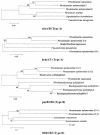DNA sequence duplication in Rhodobacter sphaeroides 2.4.1: evidence of an ancient partnership between chromosomes I and II
- PMID: 15028685
- PMCID: PMC374402
- DOI: 10.1128/JB.186.7.2019-2027.2004
DNA sequence duplication in Rhodobacter sphaeroides 2.4.1: evidence of an ancient partnership between chromosomes I and II
Abstract
The complex genome of Rhodobacter sphaeroides 2.4.1, composed of chromosomes I (CI) and II (CII), has been sequenced and assembled. We present data demonstrating that the R. sphaeroides genome possesses an extensive amount of exact DNA sequence duplication, 111 kb or approximately 2.7% of the total chromosomal DNA. The chromosomal DNA sequence duplications were aligned to each other by using MUMmer. Frequency and size distribution analyses of the exact DNA duplications revealed that the interchromosomal duplications occurred prior to the intrachromosomal duplications. Most of the DNA sequence duplications in the R. sphaeroides genome occurred early in species history, whereas more recent sequence duplications are rarely found. To uncover the history of gene duplications in the R. sphaeroides genome, 44 gene duplications were sampled and then analyzed for DNA sequence similarity against orthologous DNA sequences. Phylogenetic analysis revealed that approximately 80% of the total gene duplications examined displayed type A phylogenetic relationships; i.e., one copy of each member of a duplicate pair was more similar to its orthologue, found in a species closely related to R. sphaeroides, than to its duplicate, counterpart allele. The data reported here demonstrate that a massive level of gene duplications occurred prior to the origin of the R. sphaeroides 2.4.1 lineage. These findings lead to the conclusion that there is an ancient partnership between CI and CII of R. sphaeroides 2.4.1.
Figures



References
-
- Bentley S. D., K. F. Chater, A. M. Cerdeno-Tarraga, G. L. Challis, N. R. Thomson, K. D. James, D. E. Harris, M. A. Quail, H. Kieser, D. Harper, A. Bateman, S. Brown, G. Chandra, C. W. Chen, M. Collins, A. Cronin, A. Fraser, A. Goble, J. Hidalgo, T. Hornsby, S. Howarth, C. H. Huang, T. Kieser, L. Larke, L. Murphy, K. Oliver, S. O'Neil, E. Rabbinowitsch, M. A. Rajandream, K. Rutherford, S. Rutter, K. Seeger, D. Saunders, S. Sharp, R. Squares, S. Squares, K. Taylor, T. Warren, A. Wietzorrek, J. Woodward, B. G. Barrell, J. Parkhill, and D. A. Hopwood. 2002. Complete genome sequence of the model actinomycete Streptomyces coelicolor A3(2). Nature 417:141-147. - PubMed
-
- Casjens, S. 1998. The diverse and dynamic structures of bacterial genomes. Annu. Rev. Genet. 32:339-377. - PubMed
Publication types
MeSH terms
Substances
Grants and funding
LinkOut - more resources
Full Text Sources

